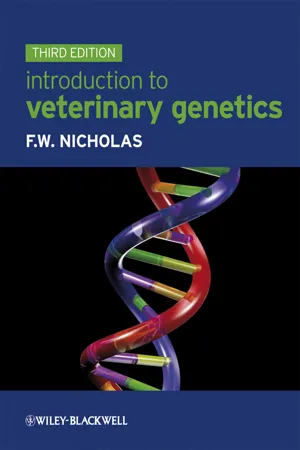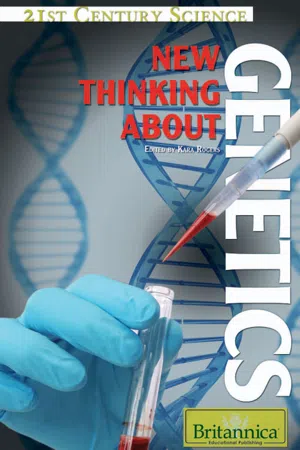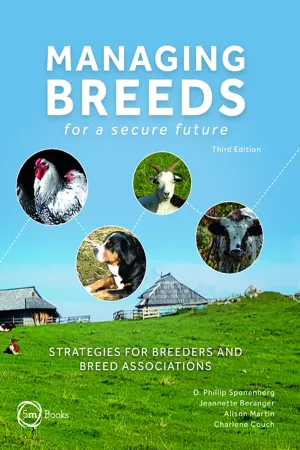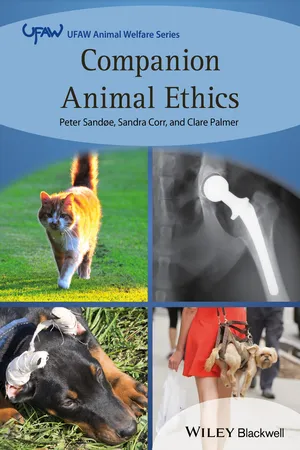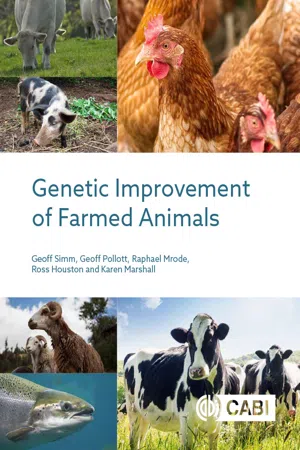Biological Sciences
Selective Breeding
Selective breeding is a process in which humans intentionally choose specific plants or animals with desirable traits to breed, resulting in offspring with those desired characteristics. This method has been used for centuries to enhance traits such as size, yield, or resistance to disease in agricultural crops and livestock. Selective breeding has played a significant role in the development of many domesticated species.
Written by Perlego with AI-assistance
Related key terms
Related key terms
1 of 4
Related key terms
1 of 3
9 Key excerpts on "Selective Breeding"
- eBook - ePub
- Odd-ivar Lekang(Author)
- 2022(Publication Date)
- 5m Books Ltd(Publisher)
section 12.12 ) are designed to achieve desired goals, and by optimal programme design the goals can be reached in a relatively short time compared to natural breeding in the wild. The effect of Selective Breeding is cumulative, meaning the breeding gain will increase from generation to generation.However, to be able to perform Selective Breeding for fish species in aquaculture some basic requirements must be fulfilled. First of all, the entire life cycle must be known and it must be possible to control and manipulate the life cycle. This is the case for Atlantic salmon where the reproductive biology and methods to artificially control the life cycle are well known. A great advantage for salmon compared to traditional animal livestock is that fertilization occurs externally. Milt can be collected from the males and eggs from the females; these are then mixed, and fertilization takes place. This makes it easy to control which parents produce offspring.To perform Selective Breeding with success, there has to be a certain genetic variation within the population, and the larger the variation, the larger the genetic progress will be. The population must also be of a minimum size to avoid problems with inbreeding depression. Inbreeding may potentially be a problem in aquaculture due to the high number of siblings and keeping control over the individuals may be a problem. The fish used for Selective Breeding ought to be individually marked to be able to identify their pedigree and avoid the crossing of near relatives.Selective Breeding has nothing to do with genetic modification. When genetically modifying a salmon, part of the process is carried out in a laboratory where either new foreign genes are introduced into the salmon or the salmon’s own genes are edited/manipulated. Which processes are included in genetic modification differs slightly between definitions. The AquAdvantage salmon is an example of a genetically modified salmon (see Chapter 5 - eBook - ePub
- Frank W. Nicholas(Author)
- 2013(Publication Date)
- Wiley-Blackwell(Publisher)
15Selection within populationsEver since animals were first domesticated, humans have been attempting to alter animal populations by means of artificial selection. The vast array of different breeds and strains of domestic animals in existence today is testimony to the effectiveness of such selection. Despite the many changes that have already occurred as a result of artificial selection, there are still many improvements needed, especially in terms of the economic efficiency of production of milk, eggs, wool, meat, and other animal products. There is also a continual demand for faster horses, better showjumpers and more intelligent guidedogs. In most situations, the traits to be improved are quantitative traits. Furthermore, there is a continual need to reduce the incidence of multifactorial disorders (Chapter 6). Exactly the same principles apply to selection against such disorders as to selection for improved productivity.The aim of this chapter is to describe artificial selection in animal populations.Estimated breeding values and accuracy of selectionWhen selection is carried out for any trait, the usual aim is to select as parents those animals that have the highest breeding values for that trait, out of all the candidates available for selection, so as to achieve the highest possible average performance for that trait in the offspring of selected parents. If we knew exactly the actual breeding value (called the true breeding value) of each candidate, we could achieve this aim with maximum efficiency by ranking candidates according to their true breeding value, and selecting those at the top of the list.In practice, however, we do not know an animal’s true breeding value for any trait. Instead, all we have is one or more clues to the animal’s true breeding value for various traits. These clues, which are called selection criteria, consist of one or more measurements of performance (phenotypic values) taken on the animal itself and/or one or more of its relatives. By means that are described below, we can use these clues to estimate the true breeding value of each animal for any trait, and the animals can then be ranked according to estimated breeding value - eBook - ePub
- Jack Brown, Peter Caligari(Authors)
- 2011(Publication Date)
- Wiley-Blackwell(Publisher)
7 SELECTION INTRODUCTIONSelection of all living organisms has been going on since life was first created. Natural selection (i.e. evolution) has resulted in the diversity of plant and animal life which exists today. All selection results in a change of gene frequencies. Throughout evolution, species have been changing, ‘more fit ’ genotypes have predominated while those which are less fit in regard to survival, have become extinct. The aim of plant breeding is to direct selection towards increasing the frequency of desirable gene combination which best suit agricultural systems.In order to be successful in a selection programme two criteria need to be satisfied, being:- There is variation between plants within the unselected population and the breeders must be able to distinguish between different phenotypes
- At least some of that variation must be genetic in nature
Obviously, if a plant breeder cannot distinguish any differences between plants within a population (or different populations) then it will be impossible to select those individuals which appear superior. Second, if the variation observed between plants within a population is the result purely of the environmental response of lines, with no genetic component, then there will be no progress made in a selection scheme.WHAT TO SELECT AND WHEN TO SELECTHaving decided that the two criteria above are indeed satisfied, among the first tasks to be addressed by a plant breeder are to decide what characters are to be selected for and at what stage in the breeding scheme will selection be applied .Consider the first question of what to select for ? To address this a plant breeder must refer to the breeding objectives - eBook - ePub
The History of Creation
Or the Development of the Earth and its Inhabitants by the Action of Natural Causes, Volume 1
- Ernst Haeckel(Author)
- 2019(Publication Date)
- Routledge(Publisher)
The farmer wishing to breed a special race of animals, for example, a kind of sheep distinguished by particularly fine wool, proceeds in the same manner. The only process applied in the improvement of wool consists in this, that the farmer with the greatest care and perseverance selects from a whole flock of sheep those individuals which have the finest wool. These only are used in breeding, and among the descendants of these selected sheep, those again are chosen which have the finest wool, etc. If this careful selection is carried on through a series of generations, the selected breeding-sheep are in the end distinguished by a wool which differs very strikingly from the wool of the original parent, and this is exactly the advantage which the breeder desired.The differences of the individuals that come into consideration in this artificial selection are very slight. An ordinary unpractised man is unable to discover the exceedingly minute differences of individuals which a practised breeder perceives at the first glance. The business of a breeder is not easy; it requires an exceedingly sharp eye, great patience, and an extremely careful manner of treating the organisms to be bred. In each individual generation, the differences of individuals are perhaps not seen at all by the uninitiated; but by the accumulation of these minute differences during a series of generations, the deviation from the original form becomes in the end very great. It becomes so great that the artificially produced form may in the end differ far more from the original form than do two so-called “good species” in their natural state. The art of breeding has now made such progress, that man can often at discretion produce certain peculiarities in cultivated species of animals and plants. To practised gardeners and farmers, you may give distinct commissions, and say, for example, I wish to have this species of plant with this or that colour, and with this or that shape. Where breeding has reached the perfection which it has attained in England, gardeners and farmers are frequently able to furnish to order the desired result within a definite period, that is, at the end of a number of generations. Sir John Sebright, one of the most experienced English pigeon-breeders, could assert that in three years he would produce any form of feather, but that he required six years to obtain any desired form of the head and beak. In the process of breeding the merino-sheep of Saxony, the animals are three times placed on a table beside one another, and most carefully compared and studied. Only the best sheep with the finest wool are selected, so that in the end, out of a great multitude, there remain only some few animals, but their wool is exquisitely fine, and only these last are used in breeding. We see, therefore, that the causes through which, in artificial breeding, great effects are produced, are unusually simple, and these great effects are obtained simply by accumulating the differences which in themselves are very insignificant, and become surprisingly increased by a continually repeated selection. - eBook - ePub
- Britannica Educational Publishing, Kara Rogers(Authors)
- 2010(Publication Date)
- Britannica Educational Publishing(Publisher)
Plant breeding is the application of genetic principles to produce plants that are more useful to humans. This is accomplished by selecting plants found to be economically or aesthetically desirable, first by controlling the mating of selected individuals, and then by selecting certain individuals among the progeny. Such processes, repeated over many generations, can change the hereditary makeup and value of a plant population far beyond the natural limits of previously existing populations.Plant breeding is an ancient activity, dating to the very beginnings of agriculture. Probably soon after the earliest domestications of cereal grains, humans began to recognize degrees of excellence among the plants in their fields and saved seed from the best for planting new crops. Such tentative selective methods were the forerunners of early plant-breeding procedures. The results of these early trials were conspicuous. Most present-day varieties are so modified from their wild progenitors that they are unable to survive in nature. Indeed, in some cases, the cultivated forms are so strikingly different from existing wild relatives that it is difficult even to identify their ancestors. These remarkable transformations were accomplished by early plant breeders in a very short time from an evolutionary point of view, and the rate of change was probably greater than for any other evolutionary event.Scientific plant breeding is a relatively recent development. For many centuries, the role of pollination and fertilization in the process of reproduction was not widely appreciated, and it was not until the early part of the 20th century that the laws of genetic inheritance were recognized and a beginning was made toward applying them to the improvement of plants. One of the major facts that has emerged during the short history of scientific breeding is that an enormous wealth of genetic variability exists in the plants of the world and that only a start has been made in tapping its potential. - eBook - ePub
- D. Phillip Sponenberg(Author)
- 2022(Publication Date)
- 5m Books Ltd(Publisher)
CHAPTER 7Selection as a Genetic Management ToolSelection and culling are the two sides of a single coin. “Selection” is usually used in a positive sense for the act of saving an animal for reproduction. “Culling” is the act of removing an animal from reproduction. Some breeders find references to culling distasteful due to the negative aspects of denying an animal the chance to reproduce. Selection and culling are both essential components of the maintenance of all breeds.Selection is a power tool, and as with most power tools it can either accomplish good work at a rapid rate or it can be incredibly dangerous and can end up causing great damage. Selection tends to reduce genetic variation, and if not managed carefully it can do this precipitously. Selection can be imposed by breeders, and is also always imposed by the environment (Figure 7.1 ). The consequences of selection are obvious. Selection works by assuring that some animals reproduce, and others do not. This directs the flow of genetic variation from generation to generation. A breeder’s role in directing that flow is all important in shaping the final product.Figure 7.1Selection reduces genetic diversity by deliberately removing some characteristics, while favoring others. In this example, breeders have selectively retained white circles at the expense of black and dark grey circles. This changes the frequencies of these in the descendant population. Figure by DPS.Selection assures that the more desirable animals produce more offspring than the less desirable animals do. The definition of “more desirable” and “less desirable” varies with situation and philosophy, and from one breeder to the next. The assignment of relative desirability of an animal is usually determined by performance testing in its various guises, which is discussed further in Chapter 8 - eBook - ePub
- Peter Sandøe, Sandra Corr, Clare Palmer(Authors)
- 2015(Publication Date)
- Wiley-Blackwell(Publisher)
The Selective Breeding of dogs and cats, of course, also has a positive side. Selective Breeding maintains a diversity of breeds. In the case of dogs, the wide variation across breeds in appearance, temperament, function and utility is a factor in human–dog interactions. At least anecdotally, it is clear that people show intense and often lasting affinity for specific breeds. Through Selective Breeding, breeds and individual dogs have been created with remarkable abilities and characteristics (assistance dogs, tracking and rescue dogs, hunting dogs, etc.), and Selective Breeding has been used to eliminate specific diseases or reduce their prevalence (e.g. Canine Leukocyte Adhesion Deficiency (CLAD), a fatal immunodeficiency disease in Irish Setters).However, these benefits do not eliminate the ethical issues raised by the Selective Breeding of purebred dogs and cats, on which we will focus in this chapter. We will begin by describing how the Selective Breeding of purebred dogs and cats is organised. After that, we will present what is known about the effects of breeding on animal welfare, with a focus on the negative effects on the health of purebred dogs and cats. We will then consider the issue from different ethical perspectives; finally, we will look at possible practical solutions to the problems.7.2 Selective Breeding of Dogs and Cats
Domestication of dogs and cats goes back many thousands of years, although the precise nature and timing of the domestication of the two species is contested. Selection of dogs for specific purposes and the existence of dog ‘breeds’ also have a long history. However, the establishment of purebred dogs and cats based on pedigrees – that is, where breed ancestry is recorded – is relatively recent. Most of the common dog and cat ‘pure breeds’ have been established within the last 200 years, as has the system based on organisations that keep breeding records and organise dog and cat shows, as we saw in Chapter 1 - eBook - ePub
- Geoff Simm, Geoff Pollott, Raphael A Mrode, Ross Houston, Karen Marshall(Authors)
- 2020(Publication Date)
- CAB International(Publisher)
et al., 2017). The consequence of this is that the majority of farmed aquatic species are either sourced directly from the wild, or are in the very early stages of a domestication process (Teletchea and Fontaine, 2014). This means that there is likely to be a huge amount of standing genetic variation for traits of relevance to production, and as such a substantial potential for genetic improvement in these traits. This is likely to have downstream benefits for global food security via greater utilization of genetically improved stocks and the positive impact of this on production traits.The reproductive biology of aquatic species can be highly amenable to Selective Breeding, with potential for high selection intensity and therefore genetic gain. The reasons for this include the high fecundity that is almost universal in aquaculture species. For example, an Atlantic salmon female may produce 20,000 eggs, marine finfish such as sea bream hundreds of thousands of eggs per female, and shellfish such as oysters, millions of eggs per female. Compared to terrestrial livestock, this fecundity is orders of magnitude higher, and this presents opportunities to design breeding programmes in different ways. External fertilization is often possible, where the gametes from both sire and dam can be obtained individually (in a process known as ‘stripping’) and then fertilization can be performed externally. This gives great flexibility in breeding programme design. For example, it is plausible to perform effective genotype-by-environment interaction studies (discussed below) by splitting full-sib families into groups and sending each group to a different environment. Also, critically, it is possible to measure traits that are difficult or impossible to measure on the selection candidates themselves on close relatives of selection candidates, including full siblings, which facilitates accurate breeding value estimation. However, there are also related challenges to be addressed, since each species is likely to have unique reproductive biology and associated requirements to tailor a breeding programme to address these. An example of this is mass spawning - eBook - ePub
The History of Creation, Vol. 1 (of 2)
Or the Development of the Earth and its Inhabitants by the Action of Natural Causes
- Ernst Haeckel, Lankester, E. Ray (Edwin Ray), Sir, (Authors)
- 2012(Publication Date)
- Perlego(Publisher)
Now, by what means does man produce this extraordinary difference or divergence of several forms which are proved to be descended from the same primary form? In order to answer this question, let us follow a gardener who desires to produce a new form of a plant, which is distinguished by the beautiful colour of its flowers. He will first of all make a selection from a great number of plants which are seedlings from one and the same parent. He will pick out those plants which exhibit most distinctly the colour of flower he desires. The colour of flowers is a very changeable thing. Plants, for example, which as a rule have a white flower, frequently show deviations into the blue or red. Now, supposing the gardener wishes to obtain the red colour in a plant usually producing white flowers, he will very carefully, from among the many different individuals which are the descendants of one and the same seed-plant, select those which most distinctly show a reddish tint, and sow them exclusively, in order to produce new individuals of the same kind. He would cast aside and no longer cultivate the other seedlings which show a white or less distinct red colour. He will propagate exclusively the individual plants whose blossoms show the red most markedly, and he will sow the seeds produced by these selected plants. From the seedlings of this second generation, he will again carefully select those in which the red, which is now visible in the majority of them, is most distinctly displayed. If such a selection is carried on during a series of six or ten generations, and if the flower which shows the deepest red is most carefully selected, the gardener in the sixth or tenth generation will obtain the desired plants with flowers of a pure red.The farmer wishing to breed a special race of animals, for example, a kind of sheep distinguished by particularly fine wool, proceeds in the same manner. The only process applied in the improvement of wool consists in this, that the farmer with the greatest care and perseverance selects from a whole flock of sheep those individuals which have the finest wool. These only are used in breeding, and among the descendants of these selected sheep, those again are chosen which have the finest wool, etc. If this careful selection is carried on through a series of generations, the selected breeding-sheep are in the end distinguished by a wool which differs very strikingly from the wool of the original parent, and this is exactly the advantage which the breeder desired.The differences of the individuals that come into consideration in this artificial selection are very slight. An ordinary unpractised man is unable to discover the exceedingly minute differences of individuals which a practised breeder perceives at the first glance. The business of a breeder is not easy; it requires an exceedingly sharp eye, great patience, and an extremely careful manner of treating the organisms to be bred. In each individual generation, the differences of individuals are perhaps not seen at all by the uninitiated; but by the accumulation of these minute differences during a series of generations, the deviation from the original form becomes in the end very great. It becomes so great that the artificially produced form may in the end differ far more from the original form than do two so-called “good species” in their natural state. The art of breeding has now made such progress, that man can often at discretion produce certain peculiarities in cultivated species of animals and plants. To practised gardeners and farmers, you may give distinct commissions, and say, for example, I wish to have this species of plant with this or that colour, and with this or that shape. Where breeding has reached the perfection which it has attained in England, gardeners and farmers are frequently able to furnish to order the desired result within a definite period, that is, at the end of a number of generations. Sir John Sebright, one of the most experienced English pigeon-breeders, could assert that in three years he would produce any form of feather, but that he required six years to obtain any desired form of the head and beak. In the process of breeding the merino-sheep of Saxony, the animals are three times placed on a table beside one another, and most carefully compared and studied. Each time only the best sheep with the finest wool are selected, so that in the end, out of a great multitude, there remain only some few animals, but their wool is exquisitely fine, and only these last are used in breeding. We see, therefore, that the causes through which, in artificial breeding, great effects are produced, are unusually simple, and these great effects are obtained simply by accumulating the differences which in themselves are very insignificant, and become surprisingly increased by a continually repeated selection.
Index pages curate the most relevant extracts from our library of academic textbooks. They’ve been created using an in-house natural language model (NLM), each adding context and meaning to key research topics.
Explore more topic indexes
Explore more topic indexes
1 of 6
Explore more topic indexes
1 of 4

